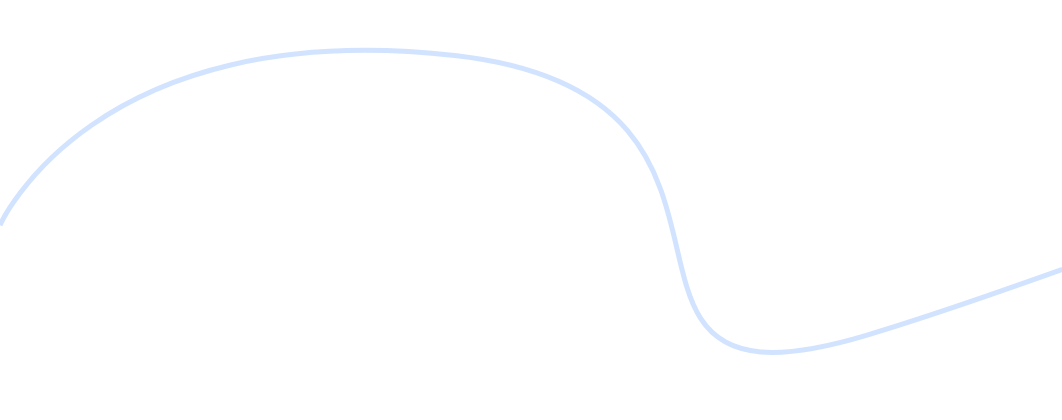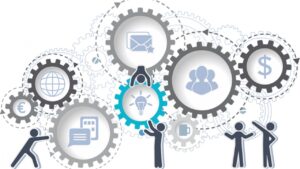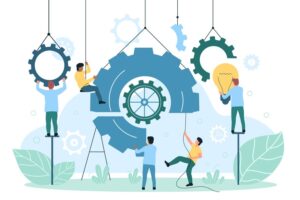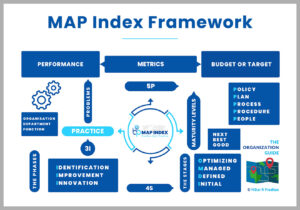You need a different checklist and different mental models for different companies. I can never make it easy by saying, ‘Here are three things.’ You have to derive it yourself to ingrain it in your head for the rest of your life — Charlie Munger
Mental Models are the way we understand and interpret the world. They shape the way we think, and the way we make decisions and take actions. We are in constant interaction with nature. We are fed with a stream of information. We are a machine of sensory experience. We have to make sense of these things. Most go past us and we have no clue and even if we have some idea, we can do very little about it but we have some other things that remains within our radar and we process those things. We have our cognitive capabilities; it can do so much and not more.
How to augment and accelerate?
We can always develop the capabilities and enable our cognitive apparatus to build a better respond mechanism. The world out there is too cosmic for our head to have a lucid image; it can merely have some representation of the various phenomena that are happening. In a way it tries to simplify the complexities.
Our minds cannot comprehend and process the complexity in its entirety. We cannot store the full details of everything that is happening around us. We can only have an icon or a symbol to representation those arrays of things. This is only to facilitate our brain to quickly process things. When we are facing some critical situations, the mind cannot wait for the brain to take its own time and then get the instruction to act. The body feels deeply threaten and if not responded, it reacts and behaves erratically as it has no clear directives. We are on the treadmill of life. We have to have our eyes and ears open, sense things quickly and respond appropriately to situations as they come. It is so much about the preparation of our mind to handle such situations. The better prepared we are the better is our response. The bulk of our preparation revolves around the concept of mental models.
The questions to be asked;
- How we have developed our mental models?
- How are we deploying those mental models?
- What the kind of experiments we have done with different mental models?
- Are we fully cognizant of the importance of mental models?
Mental models are some kind of frameworks or concepts through which we can view and review the world. They are like our toolkit. Having the kit is one thing and learning how to use them is another thing. This is not something we do it once and we are ready to go. This is not something we acquire it once and we needn’t have to do anything. There is a lot to be done to harness the potential of mental models and hone our abilities to manage the usage of mental models.
After all we are all in the business of thinking and making decisions. Thinking is something that we simply cannot stop it. This happens and to make it potent we have to make it happen. Making decisions are something that we cannot escape or avoid. We can delay but it has its own set of consequences. The state is like the devil and the deep sea. The more we think, the more junk we create, we need to moderate our thoughts and rationalize our thinking. We need to give our mind the much needed space to rest. We cannot always make right decisions and some decisions will invariably go wrong, we will be in trouble and we need to learn how to handle such situations.
It’s not a straight line equation, where we can just pick up the best mental model off the shelf and deploy to get the problem solved in the best possible way. It doesn’t happen that way. There is series of iteration that goes into the perfecting the work. We have to keep doing. We keep learning. This is a process of learning that we have to keep learning. We can term this special set of learning as the meta-learning. This can change the way we learn everything.
In a way this becomes our master toolkit, and we need to build our mastery on the various tool set inside the kit. The nature of the problem that we face keep changing its color and contour, many times the same problem comes in an altogether different form, and we get confused. We lose vital time in figuring out the problem, though the solution is available but we don’t know which one to pick. The problem is in the problem not in the solution. Hence, analyzing and understanding the problem is so important to getting it effectively solved, the faster we are able to do that the better we are in a position to take decisions and put thoughts to action.
In the ultimate analysis, it is the actual action that matters. We cannot keep analyzing things incessantly. If we keep doing the analysis we will be caught in the syndrome of “paralysis through analysis”. This will not take us anywhere; instead it will create more problems, aggravate the situation making things more complicated. We are then setting in the wrong direction. We were to simply things not complicate the matter on our hand. We have enough problems in our plate. We need to keep clearing them systematically rather than accumulating.
Scientists generally agree that no theory is 100 percent correct. Thus, the real test of knowledge is not truth, but utility — Yuval Noah Harari
There is one aspect of our working where we get blocked in our ways of thinking. Soon or later, we all get labeled as specialist or generalist based on the kind of work we do. The problem is not in the label but the impact that labeling has on our thinking. Once we start wearing one of those hats, we tend to think through that lens only. Particularly so if we are a specialist and so much more value is attached to being a specialist, we get carried away.
As a specialist instead of having a matrix of mental models we have a limited set of models that are used in our sphere of working. A doctor will have his set of mental models. A surgeon tends to see everything from the physiological perspective. An engineer will have his set of mental models. A computer engineer tends to see everything from a system perspective. A lawyer will have his set of mental models. A criminal lawyer will see everything from a crime perspective. A chartered accountant will have his set of mental model. A financial accountant will see everything from an accounting perspective. The list goes on…
Well, the first rule is that you can’t really know anything if you just remember isolated facts and try to bang ‘em back. If the facts don’t hang together on a latticework of theory, you don’t have them in a usable form. You’ve got to have mental models in your head. And you’ve got to array your experience, both vicarious and direct, on this latticework of models — Charlie Munger
Though everything is doing what they are meant to do working but the problem is we cannot keep using the same mental models for solving different set of challenges that we keep encountering. There are many such problems that are in our disciplines that can solved in a better way using mental models from other disciplines but we don’t do as we get conditioned and biased. More so we don’t know or even if we learn, since we don’t use it frequently we tend to forget.
In doing so, we miss out in solving those problems innovatively and creatively, instead we keep doing it rather routinely through our standard regime. We do nothing different. Nor do we create an opportunity to learn something new. We need to think differently. We can always do things differently. We can make a big difference by thinking different things and doing things differently. We can do so provided we have ably trained our brain and prepared our mind to refrain from doing the same things and reframe itself to do different things or do the same thing differently. In doing so we are putting our existing mental models to different exercises plus we are creating space for new mental models enter the scene. We have to keep refurbishing and refilling our reservoir of mental models.
What are some examples of mental models and how do we use them?
There are mental models for every occasion and there are problems where we can use a combination of mental models to arrive at the best possible solution. Designing a mental model is science and using is so much an art. In a way it is the art and science of mental models.
There are mental models to our thinking and the way we process our thoughts. We have the mental model in the form of “first principles thinking”. It is essentially the proactive practice of questioning every assumption we think we know about a given problem and then coming with as much as new solutions as possible even many which appeared impossible suddenly appears possible. There’s a kind of magic touch to the working of work.
How Jeff Bezos is able to create Amazon, the world’s largest company in the shortest possible time?
How Elon Musk is able to innovate and manage multibillion dollar companies across so many different verticals at the same time from Paypal (Financial Services), Tesla Motors (Automotive) and SpaceX (Aerospace) to Solar City (Energy).
Why only few are able to do it and most other fail. What then is this missing piece in the jigsaw puzzle for creating innovatively and accelerating things to achieve unprecedented success?
The missing piece is hidden in the way they think. How they are able to think and most of us aren’t, we are so much close in our makeup but what set them so much apart from us they it appears as if they are from a different planet, and ironically we feel alienated. Elon Musk refers to this framework of thinking as the reasoning from first principles rather than reasoning through analogy. This is nothing but a mental model. They have mastered not just how to use it but they are gone ahead and done some innovation in the way it is deployed. All our prior assumptions and existing beliefs are thrown out of the window and a full door is opened for new things to come in and do so abundantly.
We have “thought experiments” as another set of mental models. It is an imaginary situation that we construct in which a hypothesis, theory, or principle is laid out for the purpose of thinking through its consequences. When we are inquiring into the nature of nature and the way many things function, and we have no clue to get any lead. These are some of the experiments which are so amorphous and abstract in nature that it cannot be conducted in physical labs.
In such situations what do we do? How do we go about doing our business? The way out is through thought experiments. Especially, in philosophy to psychology there are hypothesis where we cannot conduct any physical experiments, not just in these disciplines but it has happened in the primary subject of physics where theory was developed using thought experiment.
Einstein’s changed the way we looked at our reality by changing our fundamental perspective; it was a paradigm shift in our mental model and he did it using another mental model. One of Einstein’s most remarkable ability was that of conceptualizing complex phenomenon and grand scientific ideas by imagining those real life situations and examining multiple such scenarios in mind.
If I had an hour to solve a problem, I’d spend 55 minutes thinking about the problem and 5 minutes thinking about solutions — Albert Einstein
Einstein called these scenarios gedankenexperiments, which is “imaginary experiments” or “thought experiments” in German. His thinking was predominately visual in nature. He could first design experiments in his mind’s eye and he was then able to work on it in the apparatus of his brain until he could get the ideas fully fructify and set the physical principles that are crystal clear. The famous theory of relativity is based on thought experiment which was impossible to prove otherwise.
For instance one cannot travel at the speed of light nor was it possible to convert mass into energy where we need the square of the light to be applied on mass to get back the energy. Thought experiments are conducted in our imagination. We set up a hypothesis, we observe things, and after conducting some experiments we draw conclusions. Much the same way we do real experiments, only difference in this case is we do inside our mind.
Now we have one more mental model pertaining to thinking itself. It is termed as “second order thinking”. This won’t make sense to jump into second order without giving a proper thought that is having an understanding of what that first order thinking meant. First order thinking looks for easy answers driven by our past experiences and beliefs, a prior knowledge. It is thinking within the box. These decisions are something which are obvious, simple to execute and perhaps shallow. It tends to tackle what is known, in the familiar terrain, out there to be seen by everybody and it strives to solve the present problem without any eye on the future implications. On the contrary, second order thinking as a mental model requires us to go out of our comfort zone to think literally outside the box, and even without a box. The potential impact of our decision into the future is critically analyzed and reviewed thoroughly, before any concrete action is initiated.
Mental models help us process our perception better and guide us in conducting our behaviour much better. These models literally act as our thinking tool to take decisions and solve problems. Mental model helps us to develop new perspectives in life. In essence, we can state that mental models make us understand our life better and help us to live a much more meaningful life.












